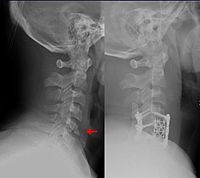
Photo from wikipedia
OBJECTIVES (1) To determine the incidence of surgical site infections (SSIs) in diabetic orthopaedic trauma patients and (2) to establish a protocol for managing diabetes mellitus (DM) in orthopaedic trauma… Click to show full abstract
OBJECTIVES (1) To determine the incidence of surgical site infections (SSIs) in diabetic orthopaedic trauma patients and (2) to establish a protocol for managing diabetes mellitus (DM) in orthopaedic trauma patients. DESIGN Retrospective cohort study. SETTING Level 1 Trauma Center. PATIENTS All diabetic orthopaedic trauma patients who underwent surgical intervention with at least one month follow-up. Patients were classified as poorly-controlled or controlled diabetic patients based on admission hemoglobin A1c and blood glucose (BG). INTERVENTIONS Orthopaedic surgical intervention in accordance with fracture type and a standardized diabetes management protocol with internal medicine co-management. MAIN OUTCOME MEASUREMENT SSI incidence. RESULTS There were 260 patients during the study period. Two hundred two (77.7%) were included in the final analysis. Seventy-five (37.1%) patients met the criteria for poorly-controlled DM. The overall rate of SSI was 20.8%; 32.0% for poorly-controlled diabetic patients and 14.2% for controlled diabetic patients (p<0.01). Admission blood glucose (BG, p=0.05), but not discharge BG, was associated with SSI incidence. CONCLUSIONS Trauma patients with poorly-controlled DM have a higher rate of SSIs than patients with controlled DM. Perioperative diabetes control does not appear to decrease infection rates in these patients. LEVEL OF EVIDENCE Therapeutic, Level III.
Journal Title: Journal of Orthopaedic Trauma
Year Published: 2019
Link to full text (if available)
Share on Social Media: Sign Up to like & get
recommendations!